Order and* chaos: stimulates imagination and creativity.
Order or** chaos: inhibits imagination and creativity, allowing some to develop a limitless power to affect the lives of others.
* and: the one blends with the other.
** or: the one excludes the other.
This Tractatus offers a new, or long forgotten, language-game. It does so, not through definitions or explanations but rather showing, as if uttering the ideas while pointing at them. It invites observers, mostly through metaphors, to explore new ways of seeing (understanding) their environments, and new ways of expressing their desires and interactions.
We may find it easy to accept the description of all phenomena in terms of processes or networks of processes. (Consider phenomena such as the movement of a limb, the explosion of a star, the “collisions” of sub-atomic “particles”, the “beginning” of the “universe” and its subsequent transformations, etc.).
We may not find it as easy, however, to grasp that a closed network of processes may distinguish itself as an observer of an environment brought forth by the same distinction. Furthermore, consider: (1) that the distinguished environment contains the observer (the closed network of processes) and (2) that from the perspective of this observer, this distinction and further distinctions resulting from the interaction between this observer and its environment appear paradoxical and logical. In other words (paradoxically), for the observer, all possibilities blend into each other (for example, exist and not exist, inside and outside, red and blue and green and… etc.) and (logically), for the observer, the possibilities appear distinguished from each other (exist or not exist, inside or outside, red or blue or green or … etc.).
Living organisms, with or without a nervous system,
constitute examples of these closed networks of processes. A nervous system,
also a closed network of processes, interacts with its environment through
closed networks of processes that involve its sensory surfaces as well as its
effector surfaces. The nervous system, therefore, interacts with its environment
(paradoxically) inside and outside itself and (logically) inside or outside
itself.
Determined largely by their biology, one or more observers, reasoning logically, distinguish a
world “out there” made of objects and events to which they attach
(through further distinctions) specific possibilities as a result of perceptual
or other characteristics and limitations, as well as a result of attempts at
acting socially. Yet these attempts also entail steps towards triviality and
away from thinking and paradoxes. Social knowledge, whether “objective” or “subjective”,
as practiced by logicians, mathematicians, scientists, technologists and others,
provides no exception. An observer may still welcome these attempts, as long
as they lead to conversation, thereby avoiding the trivialization (instruction)
of one by the other and that of many by the few.
Two or more individual observers cannot distinguish
a common world “out there” unless some evidence can convince them.
From this evidence, logical reasoning allows human observers to draw inferences
about the world “out there” that will not hold until some evidence
supports them, reinforcing the original distinction of a world “out there”.
Since new evidence may prove previous evidence wrong, this process (evidence,
inferences, new evidence, new inferences…) has no end, and it may even
call into question the original distinction of a world “out there”,
which may call into question logical reasoning itself and suggest instead a
paradoxical reasoning.
No observer “resolves” or “explains” paradoxes without
loss. This viewpoint, as shown by the Tractatus, appears essential to such
societies that humans should develop through education and art and philosophy.
The Tractatus does not say, teach, or explain what to educate; but it shows education
as if pointing at it. It also traces the origin of these seemingly outrageous
propositions to the source of all propositions: the paradoxical essence of
the observer.
If humans do not succumb to their self-inflicted shortcomings, what follows
should help them see (understand) themselves as well as the consequences of
logical reasoning alone as done by logicians, mathematicians, scientists, technologists
and others; searching for a truth as if searching for a god, they translate
everything into their own language, thus utterly missing the point. Those who
practice these disciplines soon forget or fight their paradoxical origin mostly
because those who consider themselves “well off” and/or “content” and
those who believe they will soon achieve this status, welcome, demand and/or
adapt to a logical reasoning without conflict or paradoxes, thus forcing a
status quo.
From logics to paradoxes
Consider a concatenation of words (a sentence) and call it a proposition (a
statement) invented by one or more observers to assert or express something
in a given context.
Propositions may have different meanings for different groups of one or more
observers.
Reasoning paradoxically, a group of observers may find tentative common meanings
for propositions through the language-games that define their forms of life.
Reasoning logically, a group of observers may find that some propositions do
not refer to themselves and that an observer or group of observers must assign
or determine their logic values (e.g., in a two-valued logic: true, false).
Other observers may disagree and defend with arguments different values.
Other propositions refer to themselves (self-referential propositions) and
determine their own logic values, e.g., L: “Proposition
L has now and here the value true”. One or more observers can
choose and assign either logic value (true, false) to L and since L refers
to itself it does not allow any arguments to dispute or to support this choice.
Some of the self-referential propositions determine their own “logic
value” as “true and false”, thus preventing the observer
from choosing (distinguishing) “true” or “false”,
such as the proposition: P: “Proposition P has now
and here the value false”. If one or more observers, adopting
a logical reasoning, assume that this proposition has now the value true, they
soon have to accept, under that assumption, its value as false. If they assume
the value of the proposition as false, soon they have to accept it as true,
and so on. For these observers the values oscillate: true, false, true, false
... as they attempt to determine a value. Call this proposition a paradox.
Unfortunately many authors who write about paradoxes forget self-reference
and the fusion of different possibilities as essential aspects of paradoxes,
with the regrettable consequence that many riddles, puzzles, conundrums, etc.,
pass for paradoxes.
The paradox does not allow the observer to assign one value “true” or “false” to
the proposition except as part of an oscillation, thus inviting the observer
to contemplate paradoxical reasoning and blend both values (all possibilities
in this case) into “true and false”.
Reasoning logically, the observer can only consider both values as alternating
in a time and a space resulting from the observer contemplating the paradox
from a logical perspective.
Reasoning paradoxically, the observer blends “true” or “false” into “true and false” and
hence, no time, no space, nor oscillation result from a paradoxical perspective.
With paradoxical reasoning, however, the observer blends, without conflict, all possibilities.
Hence, with paradoxical reasoning, the observer also blends paradoxical or logical
reasoning into paradoxical and logical reasoning. Therefore, reasoning
paradoxically, the observer can also make tentative distinctions in time and
space.
In a self-referential loop of propositions, derived from proposition L above,
such as the one that follows, all the propositions will have either the value
true (T) or the value false (F) depending on what value the observer chooses
for one of the propositions, say L1 (and no oscillation develops):
t1 |
t2 ... |
|||
L1: “L2 has now and
here the value true.” |
T(F) |
T(F)… |
||
L2: “L3 has now and
here the value true.” |
T(F) |
T(F)… |
||
Ln: “L1 has now and
here the value true.” |
T(F) |
T(F) |
||
A self-referential loop of propositions, derived from proposition P above, such as the one that follows, will not allow the observer to attach values to any of its propositions since their values will oscillate logically and blend paradoxically for the observer as before (notice that the values now ripple through the loop of propositions as the observer, reasoning logically, determines the value of each proposition, thus making the oscillation of values slightly more complex than shown here):
t1 |
t2 |
t3 ... |
|||
P1: “P2 has now and
here the value true.” |
T |
F |
T ... |
||
P2: “P3 has now and
here the value true.” |
T |
F |
T ... |
||
Pn: “P1 has now and
here the value false.” |
T |
F |
T ... |
||
As proposition P,
this paradoxical loop of propositions also suggests paradoxical reasoning to
the observer.
If an observer takes a narrow band of paper and glues its ends together, the
observer forms a ring with two faces (outside and inside) and two edges (right
and left or up and down, depending on how the observer holds the ring). Assuming
that each face (or edge) of the ring corresponds to a value (T, F), the observer
can see the whole ring as a metaphor for the loop of propositions derived from
L.
If the observer twists one end of the band 180 degrees before gluing it to
the other end, the observer forms a Möbius band with one face and one
edge (see the Ring and Möbius Band in the following section). As with
the paradoxical loop of propositions derived from P that, for the observer
traversing the loop of propositions, alternates logically two values (in a
time and a space) and blends paradoxically two values into one (no time,
no space), for the observer traversing the band lengthwise, this band alternates
logically two faces (in a space and a time) and blends paradoxically
two faces into one (no time, no space), and alternates logically two edges
(in a space and a time) and blends paradoxically two edges into one
(no time, no space). Notice that proposition n corresponds to the twist and
that any odd number of twists maintains the paradox and that any even number
of twists destroys it, introducing a distinction.
Logical and paradoxical toroids
If instead of a band, the observer has a tube, with a polygonal cross section,
that closes on itself forming a toroidal shape with 3, 4, 5 ... or n faces,
and each face represents a possibility (e.g., a logic value in a multi-valued
logic or a component in a closed network of processes and components) the observer
has a logical toroid from which the observer may form a paradoxical toroid
(one face and one edge) with the appropriate twist (360/3 = 120 degrees for
3 faces, 360/4 = 90 degrees for 4 faces, 360/n degrees for n faces (n possibilities)).
Ring and Möbius Band: (2 faces <=> 1 face; 2 edges <=> 1 edge) |
 |
Logical and Paradoxical Toroids: (3 faces <=> 1 face; 3 edges <=> 1 edge) |
 |
Logical and Paradoxical Toroids: (4 faces <=> 1 face; 4 edges <=> 1 edge) |
 |
For the observer traversing the resulting face lengthwise, the paradoxical toroid alternates logically n faces in a space and a time and blends paradoxically n faces into one, eliminating time and space. Reasoning logically, every time the observer returns to the point of departure after every turn around the paradoxical toroid the observer will stand on a different (and, paradoxically, the same) face. The paradoxical toroid also suggests paradoxical reasoning to the observer.
Consider now that a logical toroid, as a metaphor
for a set of components (the faces of the toroid) that do not change (no processes,
no activity), may represent the static stability of non-living things.
A paradoxical toroid, however, as a metaphor for a set of components that do
change (due to processes) into each other, represents the dynamic stability
that lies at the heart of all living organisms and at the heart of the activity
of their nervous systems.
Reasoning logically, closed networks of changing components look like this (for 2 and 3 components):
 |
 |
The arrows represent the processes and the times and spaces resulting from
the logical perspective chosen.
Reasoning paradoxically, the same networks look
like this:
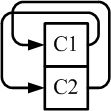 |
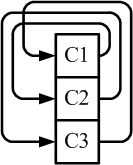 |
The arrows now represent components blending into each other, self-reference
and twist (best represented by the corresponding paradoxical toroids). Neither
time nor space results from this perspective.
From
paradoxes to logics
Until we know better, it makes sense to assume that as human infants join the
world and a society, their nervous systems, not yet subdued by training and
instruction but full of curiosity, observe (explore) their surroundings and
themselves considering all possibilities, including emotions and feelings,
unconstrained by the limitations of a logical framework.
Under this assumption, contemplate observing (perceiving) as resulting from
the activity of closed loops of processes that, crossing the sensory and motor
surfaces, lie inside and outside the nervous system. Since this activity
includes all possibilities, these loops must resemble the paradoxical toroids
discussed above and play the role of paradoxical contexts where the uninhibited
infant observers, reasoning paradoxically (logical reasoning still incipient),
make tentative distinctions.
Moderate instruction and training can force these observers to consider only
part of their paradoxical toroids (a part that each observer can make to coincide
with part of the toroids of other observers) so that only logical reasoning
emerges. On the other hand, extended rigorous instruction and training can
force the observers to untwist their paradoxical toroids (to make a logical
toroid). Unlike the first case, which may prove reversible and lead to a somewhat
flexible observer, the latter case may prove irreversible and lead to a rigid
observer who considers logical reasoning alone.
Most observers succumb to these methods of coercion and relinquish the paradoxical
view (the whole paradoxical toroid). This reveals the essence and origin of
all logical reasoning: a social convenience extricated from a paradoxical context.
The extraction, however, reduces a priori the possibilities (the available
choices) for these observers.
Logical reasoning
Logicians and mathematicians have carved and extracted (painstakingly, brilliantly)
the whole edifice of logical reasoning out of these same paradoxical loops,
so that this edifice may please as many logicians and mathematicians as possible.
The carving and extraction, as before, reduce a priori the possibilities (the
available choices). The same applies to science and its applications, and to
any other activity in which the observers attempt logical reasoning alone.
Logical reasoning alone, and a “logical” language derived from
it, for all the benefits it has given to humans, mostly allowing them to build
and destroy things together, has deprived them of wisdom; and because different
groups of humans often do not share the same logical reasoning, it has also
stimulated their irrationality, exacerbated by excessive and unnecessary differences
in wealth and power.
Observers that use only logical reasoning have always attempted to distance
it from its paradoxical origin, as shown by the histories of logics and mathematics.
These histories reveal an abundance of branches sprouting from these disciplines,
most of them, if not all, dedicated to the eradication or isolation of paradoxes.
This unveils disciplines concentrated in them, inside their own languages and
their growing abstraction; lacking also the philosophical outlook, it makes
them increasingly unfit to contribute to a better society of humans.
An
example
Many paradoxical loops have inspired useful or useless applications such as
the logical inverter with feedback used as an oscillator (e.g., clock(s) at
the heart of digital computers), or the electromagnetic buzzer used in electric
doorbells, or the paradox of the liar and many others that inspired and bedeviled
many logicians and mathematicians. The example presented below also suggests
the insight that paradoxes may bring to logics, mathematics and the sciences, if
humans would allow them as part of reasoning; as if humans would listen to
troublemakers rather than shutting them up.
When an observer enters a room at night, the observer usually turns on an electric
light using a switch near the door. The corresponding electric circuit follows.
V stands for a source of voltage and L stands for the light. The switch SW
allows the flow of current (light on) when closed and prevents it (light off)
when open.

If the room has several doors, the observer would
like to have a switch by each door, so that each of the switches can turn on
or off the same light.
A paradoxical approach to this problem offers an interesting solution, rich
in possibilities and meanings. Modify the circuit as follows:
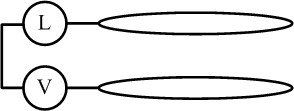
Instead of the switch the circuit has now two rings made of electrical wire. Visualize these two rings as the two edges of a band like the paper ring considered above. If the observer manages to twist this band to form a Möbius band, the two wire rings will form one continuous wire, thus closing the circuit and turning the light on. The observer can do this with a so-called Double Pole Double Throw (DPDT) switch as follows:
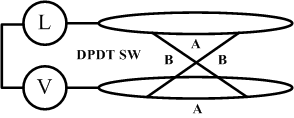
With the switch in position A (A closed, B open), the two wire rings remain isolated from each other (light off). With the switch in position B (A open, B closed), the two wire rings cross (twist) into each other forming one continuous wire and turning the light on. The observer may connect as many of these switches around the rings as the observer wishes. Just as in the paradoxical loop of propositions only an odd number of switches in position B (twist) will turn the light on. Notice that the operation of the circuit contemplates logic and paradox, distinction and absence of distinction. If the observer places one switch by each door of the room and wires them accordingly, the observer may turn the light on or off from any of those doors.
Moreover, depending on where among the switches the observer connects the voltage source and the light to the wire rings, different operations of the switches result.
(I built this circuit with five DPDT switches
and it operates as I have described it).
A metaphor
Imagine a network, say, of a hundred nodes arranged in a 2-D (two-dimensional) matrix of 10x10 elements interconnected horizontally and vertically (a 2-D interconnection of nodes). Make each node an oscillator and its oscillation observable as a light that the node turns on (red) and off (white) with a given frequency. (See top half of the figure below). A basic oscillator consists of a logical inverter within a paradoxical loop (a loop with a “twist” such as the Möbius band). As with a paradox the oscillation develops in a time and a space resulting from the observer contemplating the oscillator from a logical perspective. (Many configurations of elements in a recurrent loop can make oscillators of different kinds and complexities such as electrical, mechanical, optical, biological, etc.). In the network, all nodes oscillate at approximately the same frequency. When a node turns off its light, it sends an excitatory signal to its four neighbors (up, down, right and left, including a wrap-around at the borders of the matrix) so that their lights turn on. This activity coming from the nodes synchronizes the whole network so that it oscillates turning on and off alternate lights (vertically and horizontally) at instants (t1, t2, t3, t4, t5, t6…) and it also provides innumerable paradoxical loops. The wrap-around, structural or not, operates from an even row (column) to an odd one or from an odd to an even one. (I built this network and it operates as described).
The dynamic stability of the activity in the network, clearly more complex than that in each of its nodes, offers many paradoxical contexts (all possibilities) where the observer may choose (distinguish) among concurrent alternatives:
(If the number of lights selected for each group increases, the number of possible patterns formed as the observer chooses the neighboring lights increases even more. This happens even for a modestly sized network such as the one considered here. Notice that the observer cannot follow all the possible patterns, thus unavoidably missing the ones not followed, much as any observer can handle only so much and no more of its environment, missing the rest).
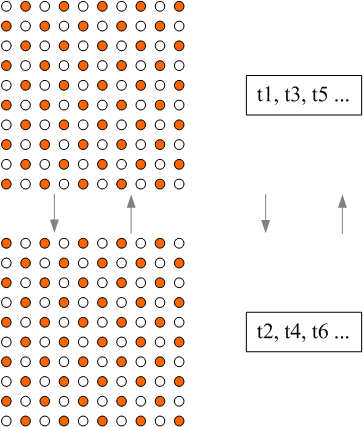 |
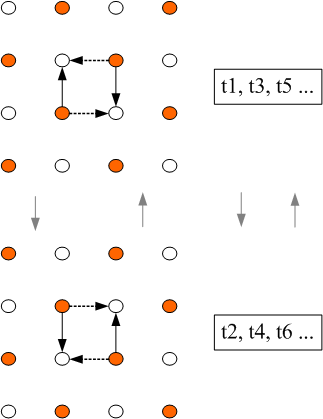 |
The choices of the observer do not affect the
oscillation of the network but without the network’s activity the observer
cannot choose. On the other hand, without an observer the activity of the network
makes no sense.
Adding light sensors to the network, an external (to the network) light may
affect the dynamic stability of the network’s activity and some of the
neighbors may not turn on when expected or vice-versa, thus changing the number
of choices available to the observer. This suggests that the network can have
any shape: regular, as shown, or irregular.
Since the network does generate light some lights may act as effectors, and
so it can interact with another network or with itself (e.g., using a mirror).
For an observer, some of the lights may represent effector surfaces and some
of the light sensors may represent sensory surfaces of the network. In such
a network any activity somewhere in the network leads to further activity elsewhere
in the network, including the “external environment” of the network.
Inhibiting the activity of some lights, an external stimulus (e.g., light)
may lead to the partial or complete isolation of other lights. These will continue
to oscillate by themselves, but the activity of the network will disintegrate
and cease to oscillate as an entity.
Let us now observe the network of oscillating lights as a society of individual
organisms (the lights or groups of them) that interact with their immediate
neighbors. Under certain circumstances these interactions may correspond to
those of a working society, e.g., an anthill, a beehive, a human group. Notice
that for an observer not affected by the functioning of these “societies”,
these “societies” make no sense except as oscillating networks
that just oscillate (no matter how complex the oscillation) as the matrix of
lights already described.
Imagine a visitor to a foreign land where the inhabitants speak a language
the visitor does not understand, and where the inhabitants do not understand
the visitor’s language. During some time the visitor may not interact
with these people and so the visitor may act only as an observer of them and
vice versa as long as none perceives a threat or nuisance in the other. The
societies or groups that the visitor may encounter will appear only as networks
that just oscillate until the visitor learns the language and joins the oscillation
(the dance).
The activity of these oscillating networks may sustain some local damage (some
nodes stop oscillating, some excitatory or inhibitory signals blocked, etc.)
but the network as a whole continues its dance, blending dynamic stability and instability,
thus enriching the life of the group or society and that of its members. With
major damage the activity of the network may collapse.
Notice that the activity (oscillation) in the network as a whole maintains
itself because any activity somewhere in the network leads to further activity
(integrated, synchronized) elsewhere in the network, activity that returns
through many possible paradoxical feedback loops to the original activity considered.
(A circle, a sphere, with its center everywhere and with its circumference,
shell, nowhere).
It should transpire from the above that the original
2-D interconnection of nodes could grow into a multi-dimensional interconnection
of nodes and also that the activity of the nodes could grow much more complex
than turning a light on or off and that the signals between nodes could also
increase in complexity. Living organisms, for example, interact using a variety
of carriers for simple and complex signals: electro-chemical, chemical, light,
sound, dance, etc., and, of course, human language.
The following figure represents
the instants (t1, t2, t3, t4, t5, t6 …) of one node (at the center), its neighbors and the neighbors of its neighbors in a multi-dimensional
interconnection of nodes. As before, when a node “turns off (white)” all
its neighbors “turn on (red)”. With n = 4 the figure represents
a 4-D (D1, D2, D3, Dn) interconnection of nodes with 8 possibilities at each
node clearly depicted. (If Dn represents time the figure may represent a 4-D
space-time manifold). (I built this network and it works as described).
(A 1-D (1-dimensional) interconnection of nodes
offers to the observer a paradoxical context with 2 possibilities at each node
(2 neighbors); a 2-D interconnection of nodes, like the one we have discussed
earlier, offers at each node 4 possibilities (4 neighbors); a 3-D offers 6;
a 4-D offers 8; and an n-D offers 2n possibilities. (A 0-D offers none).)
To contemplate more than four dimensions the reader must imagine or draw the
additional nodes and their interconnections to the node at the center, between
D3 and Dn, and between –D3 and –Dn, as suggested in the figure.
Notwithstanding all this increase in complexity, an unimpeded network of individual
elements still oscillates no matter how complex the nodes, their signals, or
their observed behavior, and no matter how many dimensions involved in their
interactions.
The essential properties of the 2-D network have not changed: it can take any
shape, its activity has no borders, any activity leads to further integrated
activity, it resists local and temporary damage, it may interact with other
similar networks, and major or permanent damage may disintegrate the network’s
activity as an oscillating entity.
If ants lose their “language” (signals between nodes) the anthill’s
activity disintegrates as an entity. The same will happen to bees and their
beehive. And so it will happen to all social organisms (including humans) and
their societies, if they lose their “language”.
Notice, however, that for a complex set of nodes such as humans in society,
a precise and/or limited “language” such as that of ants or bees,
implies already a loss. A complex individual, already an entity in itself and
not totally subservient to a society (such as an ant in an anthill, a bee in
a beehive, etc.), requires a community of complex individuals that will interact
with the richness and flexibility necessary to achieve and preserve the best
possible life for every individual in the community.
Unfortunately most human societies organize into rigid hierarchies that require
the predictability (triviality) of their members who will rapidly lose the
richness and flexibility of their interactions, reducing them to trivial talk,
no different than the “language” of ants or bees. A society may
develop, but not of humans.
Hierarchies replace thinking and conversation with rituals, secular or religious,
where neither thinking nor conversation takes place. This reveals societies
uneasy about the present, with longings for a primitive past and with forebodings
of a future without humans.
Relaxing the arbitrary distinctions necessary to establish and maintain hierarchical
societies, to the point of eliminating the hierarchies, will accordingly allow
the richness and flexibility of interactions to recover, and thinking and conversation
to flourish again.
Consider the network of oscillators as a community of observers with a non-hierarchical
activity. Consider the perturbations that affect this activity without disintegrating
it, but that may constitute stimuli for unpredictable conflicts. The flexibility
of the non-hierarchical activity allows it to incorporate permanent conflicts
in a new dance (oscillation) or resist passing conflicts and recover its original
dance.
A non-hierarchical community of individual observers does not require rigid
distinctions and, therefore, will overcome otherwise insoluble conflicts.
Paradoxical reasoning
An observer reasoning logically does not welcome paradoxes. This observer,
rejecting a priori most possibilities, deems paradoxes as erroneous reasoning.
Therefore, an observer reasoning logically considers “logical reasoning” or “paradoxical
reasoning”.
For an observer reasoning paradoxically all possibilities count, blending into
each other. Consequently, for an observer reasoning paradoxically, to reason “logically” or “paradoxically” blends
into reasoning “logically and paradoxically”.
A living organism produces and maintains itself as a closed paradoxical network
of processes and components that distinguishes itself as an observer of an
environment brought forth by the same distinction.
A living organism, as a cell or as a multi-cellular organism, needs a favorable
environment to survive. It may also play the role of a processor that, interacting
with other similar living organisms, may form part of a close chain of processors
which, given or making a favorable environment, may lead to a new living organism
made of living organisms. To survive, this new organism must provide a favorable
environment for the survival of the constituent organisms and for their replacement
through reproduction or otherwise. The new state of affairs requires that the
constituent organisms relinquish their unpredictability (their paradoxical
reasoning) in favor of a predictability (a logical reasoning) demanded by the
new organism.
This happens, for example, to ants and bees as they submit to the anthill and
beehive respectively, the new living organism.
Returning briefly to the network of oscillators as a metaphor, each node, in
isolation, oscillates unimpeded, enabled by its internal paradoxical loop.
As part of the network, however, it must, due to the signals from other nodes,
keep its oscillation in step, as the logic of the network demands.
The activity of a nervous system, as that of other networks, requires the presence
of interconnected oscillators (in this case, one or more neurons within one
or more paradoxical loops) that generate and maintain this activity.
Thus, the neurons form a network of oscillators called the nervous system.
Otherwise, the nervous system’s activity would vanish and with it the
many possibilities it offers to living organisms.
The three-dimensional structure of the nervous system contains innumerable
neurons with innumerable interconnections. Since every neuron connects to many
other neurons, the nervous system, notwithstanding its three-dimensional structure,
functions in a multi-dimensional fashion independently of the position of neurons
and of the restrictions of 3-D space. This gives it the enormous potential
to activate a great many paths, including those that involve the environment
through effectors and sensors, essentially all possibilities, as in a paradoxical
context, where an observer makes tentative distinctions as needed to interact
with itself and its environment. Sensors and effectors provide the first tentative
distinction: the observer distinguished from its environment, where itself
and other observers dwell.
An observer, with a nervous system as potentially complex as that of a human
infant, emerges into a world already populated and shaped by other human observers.
The nervous systems of children develop through interactions with their surroundings
and with themselves considering all possibilities, including emotions, feelings
and other observers, making full use of its effectors and sensors.
The children’s nervous system activity offers a paradoxical context (all
possibilities) within which their paradoxical and logical reasoning
develops.
Other observers, some indifferent, some caring, will guide the children’s
exploration of their world; some will stimulate their logical reasoning with
a restricted view; others will stimulate their paradoxical reasoning with all
its possibilities; many will attempt to instruct them on how they see
the world. All will influence the children, succeeding in different degrees.
A fortunate child will keep its paradoxical reasoning alive and so will contemplate
all possibilities in a paradoxical context within which, through independent
thinking, will make tentative distinctions as needed. This will lead to a nervous
system that maintains its original curiosity, inquisitiveness and ability to
exercise independent thinking during the whole life of this human observer.
Such an observer will not take the society of humans for granted and will contribute
wisely to its improvement without preconceived ideas, prejudices or dogmas
that may only arise from logical reasoning alone.
A less fortunate child will inhibit its paradoxical reasoning in favor of logical
reasoning, developing a nervous system that will lose its original curiosity,
inquisitiveness and independent thinking. At best, this child will grow into
an indifferent member of the society of humans, one that will instruct rather
than educate the young. An unfortunate society with most members immersed in
logical reasoning will succumb to the recursion already mentioned in the preface.
Soon after their early infancy humans also develop the capacity to reflect
upon their actions and thoughts. An unfortunate society inhibits this development
through arbitrary hierarchies that limit the possibilities of the nervous system
and soon most of its members lack this capacity and live totally unaware of
this vacuum within others and within themselves.
Rather than relying on logical reasoning and on searching for a “truth”,
the Tractatus proposes to rely on paradoxical reasoning and on exploring all
the possibilities; thus, logical reasoning appears under a new light.
As with paradoxes, no observer may “explain” the Tractatus or any
of its propositions without trivialization and loss. The propositions of the
Tractatus do not say, teach or explain; they show. They invite observers
to elude the comforts of trivialization, to explore and increase, through education,
the alternatives, to blend paradoxes and logics, and to elude the instructed
distinctions. To accept this invitation requires courage because the Tractatus
destroys many cherished notions and habits, tearing away from contemporary “civilization”,
forms of life and language.